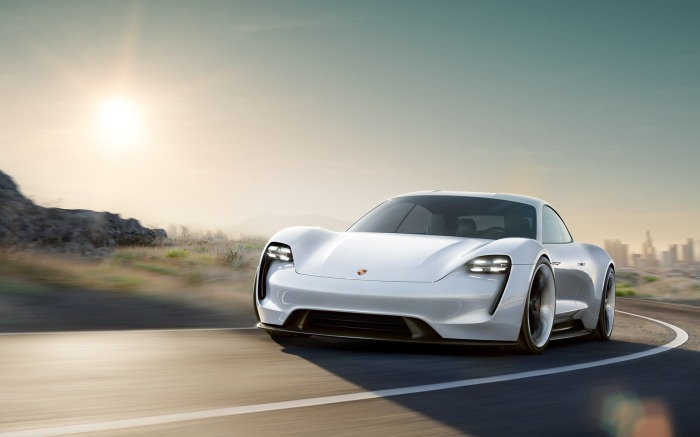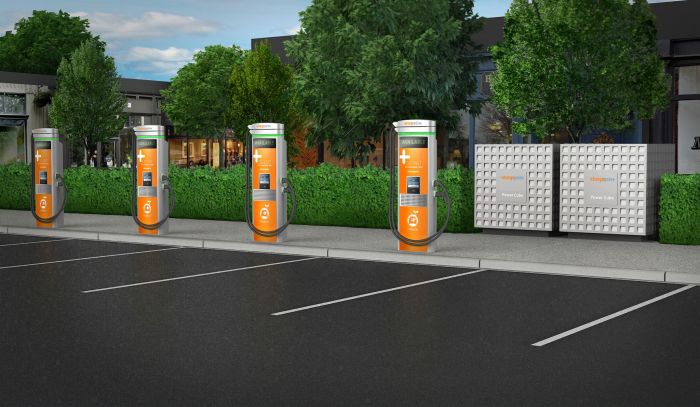
Porsche has been working on a new all-electric Mission E which will push the boundaries in a big way on ultra-fast charging. The brand aims to be the first production car that will charge at over 200 kilowatts and in order to achieve that it would also be the first to charge at around 800 volts.
The SAE J1772 standard defines the AC charging plug used in all non-Tesla North American EVs and also likewise defines the DC charging plug, also known as the CCS Type 1 plug, that is being used by Porsche in the Mission E. A different variant of the CCS plug, Type 2, is used in Europe.
Ever since 2012, the J1772 standard has had its upper limits on DC charging set to 200A at 500V. This limits charging power to a theoretical peak of 100 kW although for various reasons almost all actual J1772 DC charging equipment has been designed to support only a maximum of 125A and about 50 kW so far.
Some of the new updates to the international charging standards are still in the final stages of being published but in October of 2017 SAE made 400A at 1,000V the new official DC limit for J1772 and CCS Type 1. This is achieved using the same plug design that was previously limited to 200A at 500V so everything stays compatible.

This marketing illustration from ChargePoint shows four of their new Express Plus pedestals with dual CCS and CHAdeMO cables that support 800V charging. Two nearby Power Cube enclosures contain additional circuitry to support ultra-fast DC charging.
The new higher amperage limits are enabled by liquid cooling of the charging cable and plug. Although a charger may support higher charging rates, the actual power delivered at charging time is controlled by the car itself.
See Also: J1772 updated to 400A DC at 1000V
Just using the new 400A limit alone is not enough for Porsche to achieve over 200 kW charging. The charging voltage would be limited to around 400V due to the way battery packs in real cars are designed and when 400A and 400V are used to together that’s only a mere 160 kW. That’s why Porsche will be doubling the usual 400V when connected to a DC charger that supports the new higher limit. With twice the voltage the car could, in theory, draw around 320 kW.
A car’s battery pack voltage is a result of how the individual cells are configured into parallel groups and how those groups are connected in series. Cells can be electrically connected in “cell groups” in parallel so as to effectively become bigger cells with more energy storage capacity at the same voltage. Individual lithium-ion cells are typically only about 3.6V but when strung one cell to the next in “series” the voltage adds up. Typically, between 96 and 108 cells are strung together like this to get a total nominal battery pack voltage ranging from around 350 to 400 volts.
The individual battery cells do not electrically “see” this higher-level pack organization. Thus, the cells in the pack do not inherently gain the ability to individually charge faster just because the overall pack voltage has doubled from 400V to 800V due to more cells being strung together in series. The design of the cells typically used in high-capacity battery packs may need to be changed in order to fully take advantage of the higher charging power enabled by higher pack voltages. That’s a subject for another article.
Older DC chargers
Many and probably most of the new-generation of DC chargers will be capable of putting out the higher voltage levels even when configured for more modest overall power output. For example, ChargePoint’s new line of charger hardware supports configurations with output limits as low as 63 kW and 156A. That is only modestly higher than the 50 kW and 125A limits of older products yet the new equipment supports voltages up to 1000V mostly because it shares internal components with higher-end charger products.
The older charger designs with a 500V limit have already been installed at thousands of locations and that generation of equipment may continue to sell for a few years at discounted prices to charging providers for use in so-called community charging near residences and businesses or in rural areas with limited utility power and low traffic volume.
Porsche has said that the Mission E can charge at older stations limited to 500V. This means the battery pack has to somehow adapt to handle the correct charging voltage.
One way is to add some additional “DC to DC” circuitry inside the car between the DC charger and the battery pack that can boost the incoming voltage from around 400V to around 800V but building the circuits to do this at over 100 kW might be too expensive or bulky.
Another alternative is to build two 400V sub-packs that are connected together in parallel as one pack at chargers that are limited to 500V but connected in series for 800V at chargers that can handle the higher voltage limits. This dynamic reconfiguration of the internal pack connections can be done using giant relays called “contactors”.
Contactors are already used in battery packs in order to disconnect the pack from the charging connector pins for safety reasons when not charging. Contactors are also used to disconnect the pack from the rest of the car when it is turned off or after a major collision.
Porsche hasn’t disclosed how the Mission E will implement support for charging at 400 volts versus 800 volts.
Update: Porsche actually added a “DC to DC” voltage converter but it only handles 50 kW by default. Customers have the option to upgrade it to handle 150 kW.
See also: Should Porsche Taycan buyers pay for the 150 kW “DC charger” option?

The Porsche Mission E concept car shown while not charging at 800V.
The engineers also have to decide which voltage level the rest of the car uses. It’s entirely possible to quick charge the battery at 800V but actually use 400V when driving.
The advantage of using 400V is that more “off the shelf” parts are available from suppliers. Existing high voltage parts like cabin heaters and the like can also be reused from earlier 400V vehicles like the VW e-Golf and some existing cable connectors can be reused that have not been certified for 800V.
The internal wiring and components inside the motor may also be somewhat easier to electrically insulate at 400V although the motors used in hybrids from Toyota, Honda, Hyundai and other companies already use battery power boosted up to 600 to 700 volts in order to improve their torque density.
As far as the Mission E, a Porsche spokesman has been quoted as implying that the engineering team actually decided to design all of the car’s components to work at 800V.
Either way, there may need to be a modest DC to DC voltage converter circuit to feed some high voltage components like the cabin heater when the car is charging at the “wrong” voltage.
The extra bits of circuitry or extra contactors necessary to handle both voltage ranges add cost. Most electric cars in the near future will be using battery cells tuned for high energy density, modest charging rates and low cost. So, only a select few luxury and sports cars may be enabled for charging above 500V for now.
A few other car makers, primarily Nissan, use a Japanese DC charging plug called CHAdeMO. That standard is being updated to support 1,000V charging later this year but no vehicle designs have been announced yet that will take advantage of it.
Addendum: the Mission E concept became the Porsche Taycan.
Categories: Charging
Great articles Jeff! Thanks for taking the time to write them and for setting up this site. It’s also very nice to get the whole article emailed!
LikeLiked by 1 person
Thanks.
I try to get everything right before hitting the “publish” button but often I find things to tweak soon after.
Please let me know if you find errors although check the online version first to make sure I haven’t already fixed it.
LikeLike
Sure. It’s tricky to get things to where there isn’t a single error in an article. I’m glad I found out about this tho.
LikeLike
Good article Jeff. I think Tesla is doing the truck battery like you suggested where they can isolate the pack into lower voltage packs that enables them to charge at existing super chargers. So just because we see the Semi Charging at an existing supercharger doesn’t mean the truck is an old 400 V system.
What I’m waiting for is what changes Porsche has made to the cells themselves to a allow a higher charging power. I know you can get more discharge power out of any given chemistry just by changing electrode thickness. I’m not sure if that enables higher charging power though. I suspect it does somewhat though.
If you look at the article I published over at IEVs: “Engineering Analysis: Tesla Roadster specs validated” you see that Tesla is using 200 kwh battery in the Roadster for power not range. This implies they are sticking with their existing lower power cell design. They do this for a reason though as thick electrodes and lower power also give them the highest energy density by weight and also the lowest cost.
However I think the Germans are taking a different tack in Mission e. I think they will opt for thinner electrode thickness to get the power they need without needing quite as many kwh’s as they would with Tesla’s cell design.
Whether they can get the charging times they are talking about just by tweeking electrode thickness???????????-I don’t know.
I’m anxious to find out what chemistry they will use. I suspect it will just be NMC (622?)or (811?). So an NMC battery with a tweeked electrode thickness,, is that enough to get the charging times they quote???
What do you think?
LikeLiked by 1 person
It’s an interesting topic, for sure. You may be right that doubling up on the battery capacity in the new Roadster is more about power discharge and charging speed.
LikeLike
Jeff – I noticed a just-published SAE paper listed on the tech program schedule at WCX18 – Honda has a power DC-DC voltage booster in the new Clarity PHEV.
https://www.sae.org/publications/technical-papers/content/2018-01-0415/
Technical question – How does boosting motor input voltage increase torque density? I have always assumed that for synchronous PM-rotor motors, design torque was proportional to the rated amps of a given stator winding/rotor magnet configuration and that increasing rated motor input voltage increased power density, but not torque density.
LikeLiked by 1 person
Thanks for the pointer to the Honda tech paper. I skimmed through the schedule of talks a few weeks ago before the papers were available so now I need to go back decide which, if any, are worth downloading. I’ve got a large stack of other things to read… 🙂
As for the effects on the motors of boosting the voltage I’ll have to get back to you later as I don’t have the references handy. It’s probably worthy of a separate article.
LikeLike
You can review free online previews of many of the papers to help you decide which to buy. The Honda paper also has detailed vehicle speed vs power maps on the various ICE, blended, and electric drive modes.
I for one would love to learn more about the benefits of DC voltage-boosting downstream of the battery. Thanks for the great coverage!
LikeLiked by 1 person
What about the new solid state Li batteries (“The Holy Grail of Batteries”-Pop Mech-Jan/Feb 2022, pg. 40).
Porsche proposes to build in their own plant. Charge times of six (6) minutes have been alluded to.
(As of 12/30/21)
LikeLike